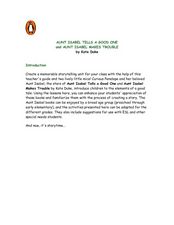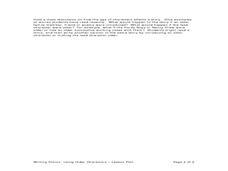Curated OER
Interpreting Characters, Setting, Plot, and Theme - The Triangle Shirtwaist Factory Disaster
Examine story development and historical disaster with your class. Learners view a video depicting the incidents surrounding The Triangle Shirtwaist Disaster. They use graphic organizers and the Internet to gather enough information to...
Texas Education Agency (TEA)
Archetypes, Motifs, and Plot in Drama (English II Reading)
The second interactive in a series of 10 introduces young scholars to character archetypes, archetypal plot patterns, and archetypal motifs, including the use of color. Learners read passages explaining the term and study examples from...
Springfield Public Schools District 186
The Crucible Quiz
Check that your class is keeping up with and understanding the reading with this straightforward reading check quiz for Act I of Arthur Miller's play, The Crucible. There are 25 questions total, which cover characters, plot recall, and...
Curated OER
Creating Interesting Characters
What makes a story interesting? Complex characters! As part of a series of worksheets that prepares middle schoolers to write their own novel, the exercises included explain the role of the protagonist, the antagonist, and the supporting...
Curated OER
After Reading: "Plot the Plot" Activity in the Library Media Class
"Plot the plot" of "The Adventures of the Speckled Band" with your young readers. Take a few days to read Sir Arthur Conan Doyle's short story as a class or in pairs, having learners write down what they consider to be the most important...
Curated OER
Plot and Conflict in W.W. Jacob's "The Monkey's Paw"
Tenth graders analyze the use of literary elements in W.W. Jacob's "The Monkey's Paw." Literary analysis is accomplished by a review of the plot and order of events in the story. Learners work in pairs to match the events from the story...
Curated OER
Lesson Plan 4: Creating Main Characters
Creating a good main character is a must when writing a creative narrative or novel. Elementary aged writers create main characters for the novel they are writing. They first use themselves as a models, then create a character as a...
All-in-One High School
Elements of Plot
Cinderella wants to go to the ball and marry the prince. At the end of the story, she does! But how does the plot move from the exposition to the resolution? Teach language arts learners and fairy tale fans about the basics of plot...
Curated OER
What Makes a Novel a Novel?
They always say to write what you know. This approach is used to get middle schoolers prepared to write novels of their own. Using a favorite book as a model, potential novelists respond to prompts that ask about characters, plot, main...
Curated OER
Aunt Isabel Tells a Good One...
Explore language arts by reading two similar stories in order to compare and contrast them in class. Young readers read two Aunt Isabel books, by Kate Duke, and discuss the main characters, plot, and setting. They complete a graphic...
Curated OER
How Characters Affect the Plot
How do a character’s feelings and actions influence the plot of a story? The interaction between character and plot is explored in this lesson that uses When Charlie McButton Lost Power to launch the discussion. Charlie’s love of...
Curated OER
Chatty Cherry Stories
Young artists will respond to reading children's literature, by engaging in original storytelling and representing their own images through the visual arts. Then they orally describe details of people, places, and things in their stories...
Curated OER
Elements of a Story - Plot, Characters, and Setting
Use this SMART board activity with any short story in your unit plan. The SMART board file contains a step-by-step guide to plot diagrams, including an interactive practice page and an assignment. This resource is beneficial for language...
Curated OER
Writing Fiction: Using Older Characters
Out with the old and in with the new? Not so in this lesson plan, which explores the idea of writing older characters in fiction. Students learn the value of varying their characters, exploring different perspectives, and avoiding...
Curated OER
Scene Plotting Worksheet
Think about literary elements, characters, and point-of-view. Then click on this link to have your class answer 14 questions intended to solidify, test, or review their understanding.
Curated OER
The Outsiders Study Guide
Provide this packet for your pupils as they pour over The Outsiders by S.E. Hinton. The study guide includes graphic organziers and comprehension as well as higher-level questions. Class members briefly summarize each chapter, compare...
Classroom Adventures Program
Creating Characters
Examine character in depth. Over the course of these six lessons, learners explore their own character traits, determine the traits of characters in the books they read, practice comparing and contrasting, and collaborate in small groups...
Curated OER
Create a Playbill!
Seventh graders explore the various elements found in the advertisement of a dramatic experience. Playbills are created that reflect the plot without revealing the climax of the play. Costumes, set construction, and character description...
Curated OER
Classical Dramatic Structure: Resolving a Character's Conflict
How does plot drive a play? Show this 20-slide presentation to describe the different parts of a plot. Basic vocabulary terms are included like climax, turning point, rising action, and denouement. Present this resource before reading a...
Curated OER
The Effects of Character Decisions
Learners explore characters' decisions. They play a card game in which they match a decision card with a direct effect card. Then they examine characters from The Wizard of Oz, record important decisions that they make on index cards,...
EngageNY
Close Reading to Learn about Lyddie’s Character
Scholars work in pairs to analyze the characters, plot, and setting of Katherine Paterson's novel, Lyddie. Next, they apply what they learned about the characters' feelings and motivation to perform a mini reader's theater.
For the Teachers
Sequence Plot Chart
Your kids can identify the plot sequence of a short story, but what about an informational article? Have them examine the chronological order of events in informational texts with a lesson on the sequence of events.
PBS
Plotting Pairs of Coordinate Points in all Four Quadrants to Construct Lines
Here is a instructional activity on coordinates that has pupils view three Cyberchase video clips illustrating the definition of "point" and "line." Along the way, learners will discuss what characters from the videos do, and where...
Curated OER
Character Builder
Characters in a story are more than a name to remember. Use a character builder instructional activity to write out a character's appearance, background, personality, attributes, and story relevance, including whether they are a main or...
Other popular searches
- Setting Plot Main Characters
- Plot, Characters and Setting
- Plot Characters and Setting
- Plot Setting Characters
- Story Plot Characters
- Plot Characters
- Analyze Characters and Plot

























